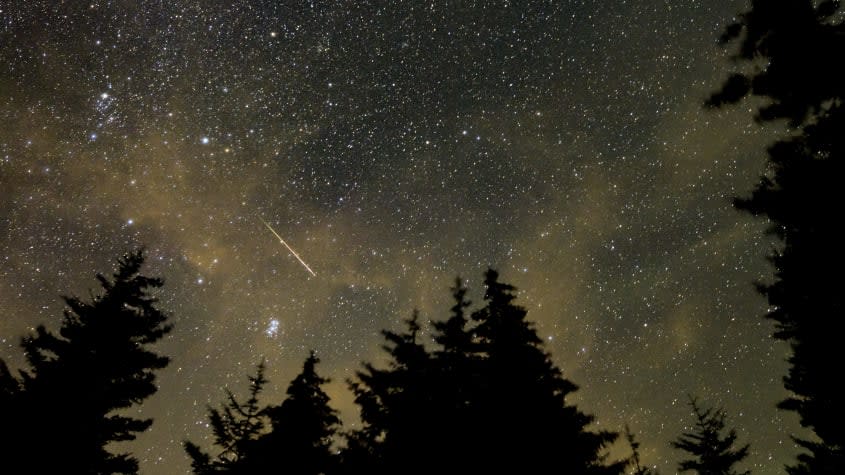The biggest and best celestial events to watch in 2023

The cosmos are always moving and changing, letting us witness exciting astronomical phenomena. These are the exciting events to watch for in the coming months.
Perseid meteor shower (July 14 - Aug. 24)
Probably one of the most popular meteor showers of the year, the Perseids take place midsummer and then peak between Aug. 11 and 12, according to the American Meteor Society. The phenomenon "is caused by Earth passing through debris — bits of ice and rock — left behind by Comet Swift-Tuttle, which last passed close to Earth in 1992," according to Space.com, which is owned by Future plc, the same parent company as The Week.
At its peak, there could be 100 meteors per hour moving at a speed of 133,200 miles per hour. The meteors also leave tails of light and color behind them. The Perseids are also called fireballs, which are "larger explosions of light and color that can persist longer than an average meteor streak," NASA wrote. The phenomenon is best viewed in the Northern Hemisphere just before dawn. It also helps to go to the darkest possible location and let your eyes adjust for 30 minutes, per Space.com.
Lunar occultation of Antares (Aug. 24)
Antares is one of the brightest stars in the sky. And on Aug. 24, the moon will appear to pass in front of it for the first time since 2010, per Space.com. The phenomenon is known as "occultation," and will be visible from much of the U.S., Canada and Mexico. Expect the star to disappear behind the dark part of the quarter-moon just after twilight that night.
Blue supermoon (Aug. 31)
At the end of August, you can witness a once-in-a-blue-moon phenomenon. A blue supermoon combines the blue moon, which is the second full moon of the month, and a supermoon, when the moon is at its closest point to the Earth in its orbit, NASA explained. In turn, the moon appears larger and brighter than average. While there are four supermoons this year, a blue moon only occurs approximately once every two-and-a-half years.
The two events coming together is a rare occurrence. In addition, the blue supermoon is also the closest supermoon of the year, according to Forbes. The two together make the moon look approximately 17% bigger and 30% brighter than an average supermoon or full moon. The last blue moon occurred in August 2021.
Annular solar eclipse (Oct. 14)
This year's annular solar eclipse occurs on Oct. 14 and will be visible across North, Central and South America. This type of eclipse is when the "moon passes between the sun and Earth while it's at its farthest point from Earth," as defined by NASA. Since the moon appears to be smaller, a "ring of fire" surrounds the moon. This is different from a total solar eclipse, when the moon completely blocks the sun.
This is the second rare solar eclipse to occur this year. A hybrid eclipse, when an eclipse is both a total solar eclipse and a partial solar eclipse at the same time, occurred in the South Pacific Ocean in April. This annular eclipse will be visible in Nevada, New Mexico, Oregon, Texas, Utah and parts of California, Idaho, Colorado, and Arizona before moving through Central and South America, NASA wrote. Solar eclipses are never safe to look at directly "without specialized eye protection designed for solar viewing."
Partial lunar eclipse (Oct. 28)
The end of October will bring a partial lunar eclipse that can be seen from Europe, Asia, Australia, Africa, North America, and much of South America, according to Time and Date. A partial lunar eclipse is "when part of the moon enters Earth's shadow," as defined by NASA. The agency added that, "in a partial eclipse, Earth's shadow appears very dark on the side of the moon facing Earth."
Lunar eclipses tend to occur twice a year, and the first one occurred in May. Unlike solar eclipses, lunar eclipses can be viewed directly and last a few hours.
Geminid meteor shower (Nov. 19 - Dec. 24)
One of the last meteor showers of the year, the Geminids will fill the sky with 120 meteors per hour at its peak, which is expected on Dec. 14, according to EarthSky. The meteors travel at 78,000 miles per hour on average and tend to be yellow in color. NASA calls it "one of the best and most reliable annual meteor showers."
Unlike the aforementioned meteor showers, the Geminids come from an asteroid called Phaethon rather than a comet. The asteroid is only about three miles in length but produces a surprising amount of debris. The shower can be seen all over the world and starts around 9 or 10 p.m. but is best viewed right before dawn.
Total solar eclipse (April 8, 2024)
A total solar eclipse will be making an appearance over North America in April 2024, and another "won't be visible across the contiguous U.S. again until August 2044," CNN reported.
During the eclipse, the moon will completely cover the sun, causing the sky to briefly become darker as the moon passes through. In addition, "bright stars or planets may shine in the dark sky, and the air temperature will drop as the sun disappears," CNN continued. Viewers should not look at the eclipse directly, especially when any amount of sunlight is visible.
The last total solar eclipse occurred in August 2017 and was known as the "Great American Eclipse."
Updated August 16, 2023: This article has been updated throughout.

